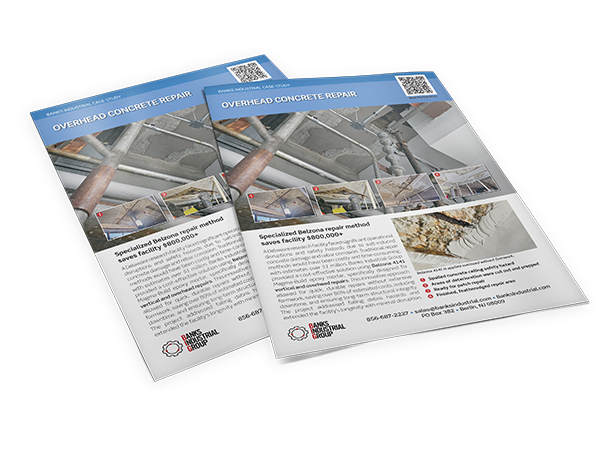
Overhead Concrete Repair Service Saves Millions
Location:
Delaware research and development facility.
Pain Point:
Salt infiltration into the loading dock concrete caused rebar corrosion and spall, leading to debris falling from the ceiling in the workshop below. This situation endangered workers and compromised the structural integrity of the building.
Research Facility's Mission:
Harnessing the power of science and technology to innovate and advance the creation of cutting-edge materials.
Plant’s Challenge:
Traditional repairs to this facility required weeks or months to complete at costs estimated at well over a million dollars.
The Challenge’s Impact On Day-to-Day Operation:
Traditional repairs would take the facility out of service for weeks or months. Loss or disruption of the shop could hamper the production schedules across the entire campus, leading to significant operational delays. Traditional repair methods would elevate costs and operational impacts exponentially.
BIG Solution: Repair With Specialized Epoxy Mortar Rather Than Replace
Banks Industrial Group delivered a solution for overhead concrete repairs that not only offers lasting results but does so at a significantly reduced expense compared to traditional repair methods.
The standard approach to fixing overhead concrete involves tearing down and rebuilding the affected areas from scratch. This process requires the use of supports and formwork to keep the wet concrete in place through its 28-day curing period. The challenge was amplified in this case by a work zone that included a busy loading area above and a mechanical space below. Pipes, ductwork, and various equipment in the space made a full demolition and rebuild even more complex.
Using concrete to patch concrete is generally not an effective long-term strategy, particularly for overhead repairs, due to concrete's weak adherence to its existing surface. Such repairs often fail prematurely.
Banks Industrial Group employed Belzona 4141 Magma-Build epoxy mortar for the project. This innovative lightweight compound is specifically designed for repairing vertical and overhead concrete surfaces. Unlike traditional wet concrete, 4141 doesn't slump or drop under gravity, allowing it to adhere to overhead surfaces with only temporary formwork. It bonds robustly to concrete surfaces and cures to a strength superior to concrete itself in just a matter of hours, not only speeding up the repair process but also ensuring durability. This makes it an ideal choice for such applications.
Estimates for conventional repairs were around $1 million for each loading dock area. However, by opting for this advanced repair technique, Banks Industrial Group was able to cut costs to under $200k per area, achieving savings of over 80% for the client.
Banks Industrial Group successfully addressed a hazardous situation involving falling concrete debris and significantly enhanced the longevity of the facility.

Salts seeping through the concrete corroded rebar, which in turn caused cracks and spall of the concrete ceiling.

Areas of concrete deterioration and corrosion were identified, cut out and primed for repair.

Area of concrete deterioration cut out, prepped and ready for filling with Belzona 4141 Magma-Build.

Specialized epoxy mortar was used to fill the damaged areas and feather edged - without formwork!
For expert information about overhead concrete repair, and other industrial solutions, contact our team today by calling 856-687-2227.
